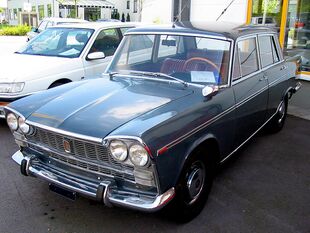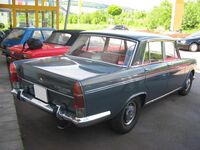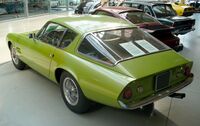Engineering:Fiat 2300
| Fiat 2300 | |
|---|---|
 Fiat 2300 saloon | |
| Overview | |
| Manufacturer | Fiat |
| Production | 1961–1968 |
| Designer | Saloon: Pininfarina Coupé: Sergio Sartorelli at Ghia |
| Body and chassis | |
| Class | Executive car |
| Body style | 4-door saloon 2-door coupé 5-door estate |
| Layout | Front-engine, rear-wheel-drive |
| Related | Fiat 1800 and 2100 |
| Powertrain | |
| Engine | 2.3 L I6 (petrol) |
| Transmission | 4 speed manual 3-speed Borg Warner automatic[1] |
| Dimensions | |
| Wheelbase | 2,650 mm (104.3 in) Speciale: 2,730 mm (107.5 in) |
| Length | 4,485 mm (176.6 in) |
| Width | 1,620 mm (63.8 in) |
| Height | 1,470 mm (57.9 in) |
| uk|uk|Kerb|Curb}} weight | 1,285–1,345 kg (2,833–2,965 lb) |
| Chronology | |
| Predecessor | Fiat 2100 |
| Successor | Fiat 130 |
The Fiat 2300 is a six-cylinder executive car which was produced by Italian automotive manufacturer Fiat between 1961 and 1968. The 2300 was made as saloon (styled by Dante Giacosa), estate car and coupé. The 2300 saloon is noteworthy as in 1966 it became the first Fiat model to be available with an automatic transmission.
2300 Coupé
Alongside saloon and estate models the 2300 range included Ghia-designed grand tourers, the Fiat 2300 Coupé and 2300S Coupé—the latter fitted with a more powerful engine with double twin-choke carburettors, tuned by Abarth. The shape of the car was first seen in public when Ghia presented it as a prototype sports coupé at the 1960 Turin Motor Show.[2] A production version, based on the newly launched Fiat 2300 saloon was presented in 1961 and went on general sale in 1962.[2] Having developed the coupé body, Ghia lacked the production capacity needed for the volumes envisaged, and were obliged to subcontract its production to OSI.[3]
The coupé body was welded to the standard floor platform of the 2300 saloon with which it shared its core components. (Despite being a new model, the 2300 saloon was in most respects a well-proven design, being a larger engined version of the Fiat 2100 that had been available since 1959.) The wheelbase was identical, but the coupé had a slightly wider track at both ends than the saloon, and final drive gearing for the coupé was increased to 3.9 (3.72 for the 2300S coupé) which translated to 20.9 mph (33.6 km/h) per 1,000 rpm.[2] Inside the 2300 Coupé featured power operated windows and other luxury fittings.
Specifications
The Fiat 2300 used unibody construction. Front suspension was by double wishbones, sprung by torsion bars, with hydraulic dampers and an anti-roll bar; at the rear there was a solid axle with leaf springs, hydraulic dampers and an anti-roll bar. The brakes were servo-assisted discs on all four corners. On most 2300s and all 2300S coupés the transmission was an all-synchromesh 4-speed manual, with optional overdrive. A Saxomat automated clutch was available as optional extra; from 1966 a Borg Warner 3-speed automatic was offered in its place.
The overhead valve straight-six engine had a cast iron block and an aluminium cylinder head. While the 2300 engine was fitted with a single twin-choke downdraught carburettor, the more powerful 2300S used two twin-choke horizontal carburettors.
| Model | Years | Engine | Displacement Bore x stroke |
Power | Fuel system |
|---|---|---|---|---|---|
| 2300 | 1961–68 | I6 OHV | 2,279 cc (139 cu in) 78 mm × 79.5 mm (3.1 in × 3.1 in) |
105 hp CUNA (77 kW; 104 bhp) 117 hp SAE (86 kW; 115 bhp) |
Twin-choke carburettor |
| 2300 S | 1963–68 | 136 hp CUNA (100 kW; 134 bhp) 150 hp SAE (110 kW; 148 bhp) |
Two twin-choke carburettors |
Derivatives and coachbuilt versions
As Fiat's flagship model, the 2300 was the subject of numerous special bodies by Italy's many coachbuilders. As they had with the 2100, Carrozzeria Francis Lombardi offered a seven-seater representational limousine based on the 2300. Sergio Sartorelli of Ghia designed the 2300 Coupé, of which Ghia also developed convertible and a more spacious fastback. shooting brake derivative called the Club.[4] Three convertibles and two Clubs were built.[5][6] Several other carrozzieri also tried their hand at making a gran turismo out of the 2300, with Giovanni Michelotti being responsible for at least four designs:
Moretti developed the 2500 SS, a 2.5-liter version with in-house bodywork designed by Giovanni Michelotti, available as a coupé or a convertible.[7] About 20 examples were built, beginning in 1962. The 2500 SS' engine was bored out by three millimetres; the resulting bore and stroke are 81.0 mm × 79.5 mm (3.19 in × 3.13 in) for a displacement of 2458 cc. It was tuned and fitted with twin double carburetors as well and produces 170 hp (125 kW) at 5800 rpm.[8] The buyer could also opt to fit the car with the regular 2300 S engine, in which case the car was called the Moretti 2300 S.[9]
Small coachbuilders Carrozzeria Savio (it) showed a rather formal looking, "transatlantic" coupé with rectangular headlights in 1963, designed by Giovanni Michelotti.[10] Four examples were built, all with more or less significant design differences - one car has scalloped sides, head and taillight treatments differ, etcetera.
At the 1966 Geneva Motor Show, Michelotti presented his own proposal to replace the Ghia coupé, but this remained a one-off.[11]
Abarth 2400
Since late 1959, Abarth had offered a series of aluminium-bodied 2+2 coupés and convertibles based on the 2100. When the 2300 appeared, Abarth continued this tradition, although there was no longer a convertible on offer. Stroking the 2200's engine created a square engine with dimensions of 79 mm × 79 mm (3.11 in × 3.11 in) and a displacement of 2323 cc. As with the earlier 2200, it has a four-speed, floor-shifted transmission, while the engine received Abarth's own cylinder head with a higher (9.5:1) compression ratio, triple Weber 38 DCOE carburetors and redesigned manifolds, and the typical, twin-tipped Abarth exhaust system. Claimed power increased to 142 hp (104 kW) at 5800 rpm; enough for the car to break the 200 km/h (125 mph) barrier. The four-wheel disc brakes were changed to Girling units from the earlier Dunlop ones.[12]
For the Turin Auto Show in November 1961, Abarth had Carrozzeria Ellena (de) and Allemano create two separate designs. The Allemano design (chassis 001) received bodywork clearly derived from their earlier 2200 Coupé, designed by Giovanni Michelotti and executed by Allemano. The original's single-piece vertical taillights were replaced with smaller round lamps mounted in a chrome panel, while the rear of the car and the greenhouse were more squared off than those of the predecessor. Ellena made a new design based on their earlier design applied to a few 2200s, with an oval grille, round wheel wells, no quarter glass, and a wraparound rear windshield. Abarth, however, was displeased with both of the proposed designs and further dismayed at the appearance of the new, Ghia-bodied Fiat 2300 Coupé at the same show. Costing a third less, Fiat's own model (albeit much heavier and with less power) undermined the case for the 2400. Abarth, always deeply involved with this car (he used a 2200 and then a 2400 as his personal transport until his death), decided to combine Allemano's front treatment with Ellena's rear, and so the production model has Allemano's more rectangular front and middle section and Ellena's vertical taillights. "Production", however, is a relative term: most sources state that 12 were built, while others say fewer than 10 examples.[12][13] By 1963 the 2400 had disappeared from Abarth's price lists, but the story was not yet fully ended: When Abarth realized that Fiat would not premiere their new 850 until two months after the 1964 Geneva Salon he had to withdraw his new Fiat-Abarth OT 850 derivative. As a place holder, he put his personal 2400 on the company stand even though the model had already been long discontinued.[13][14]
Only about forty examples of the 2200 and 2400 were built, all told, and the attempt to establish Abarth as a full fledged manufacturer of grand touring machines may be considered a failure. However, Fiat had Abarth develop the more powerful 2300 S engine and gave them several lucrative manufacturing contracts for the 2300 S (for the finned aluminium oil crankcase and some gearbox components).[12] Abarth also received an exclusive contract for putting each 2300 S Coupé through a 200 km (125 mi) pre-delivery test drive, meaning that Abarth was able to recoup most of their investment in the 2200/2400.[14] After the 2400, Abarth renewed their focus on their core businesses: small sporting cars, competition, and selling tuning parts for Fiats and others.
Ghia G230S
Carrozzeria Ghia's Sergio Sartorelli also developed a stylish coupé on 2300-basis, first shown at Turin in November 1963. The G230 S has a rakish front with low mounted twin headlights, developing a theme already seen on earlier cars like the Dual-Ghia, and a kammback rear with a large hatch and three-piece rear windshield. Unlike the Ghia-bodied official Fiat 2300 Coupé, the two-seater G230S was built on a tubular spaceframe designed and built by Gilco. Only two examples were built, plus two convertibles, but this car also served as inspiration for the better known Ghia 450 SS.
References
- ↑ "Car-by-car guide: Fiat 2300 and 2300S". Motor: 19. 22 October 1966.
- ↑ 2.0 2.1 2.2 Garnier, Peter (9 April 1970). "Used car test: Fiat 2300S Coupe". Autocar 132 (3869): 24–26.
- ↑ Ostmann, Bernd (18 November 2010). "Nachtschicht im Schloss: A report on a concours d'elegance at Schloss Bensberg". Auto, Motor und Sport 2010 (25): 40.
- ↑ "Le vedremo al Salone di Torino" (in it), Galleria Ruoteclassiche, Le fuoriserie 1956-1970. Il meglio di Quattroruote (Editoriale Domus S.p.A.) 4: 1962-1963 (57): 42-43, November 1962, May 2013, ISBN 9788872127704
- ↑ "Fiat 2300 S Cabriolet Ghia". Carrozzieri-italiani.com. https://www.carrozzieri-italiani.com/listing/fiat-2300-s-cabriolet-ghia/.
- ↑ "Fiat 2300 S Club Ghia". Carrozzieri-italiani.com. https://www.carrozzieri-italiani.com/listing/fiat-2300-s-club-ghia/.
- ↑ "Elenco delle Vetture progettate da Giovanni Michelotti conosciute al momento" (in it), Archivio Storico Michelotti (Turin, Italy), http://www.archiviostoricomichelotti.it/elenco-vetture
- ↑ Branch, Ben (2012-05-31). "1962 Moretti 2500 SS Coupe". Silodrome. https://silodrome.com/moretti-2500-ss-coupe/.
- ↑ "Fiat 2300 Coupe history from 1961 to 1969". Motor Car History. https://motor-car.net/fiat/item/25059-fiat-2300-coupe.
- ↑ "Lot 40 / 56: FIAT 2300 Coupé Savio 1963". Aste Bolaffi. https://www.astebolaffi.it/en/lot/103/40/detail.
- ↑ "Fiat 2300 Coupé Michelotti". Carrozzieri-italiani.com. https://www.carrozzieri-italiani.com/listing/fiat-2300-coupe-michelotti/.
- ↑ 12.0 12.1 12.2 Guétat, Gérald (2022-08-05). "The Fiat-based, Michelotti-styled Abarth 2400 Coupé Allemano was Carlo Abarth's magnum opus". Hemmings Motor News (American City Business Journals). https://www.hemmings.com/stories/2022/08/25/the-fiat-based-michelotti-styled-abarth-2400-coupe-allemano-was-carlo-abarths-magnum-opus.
- ↑ 13.0 13.1 Rees, Chris (2020-01-04). "1962 Abarth 2400 Coupé Allemano". Drive-MY. https://drive-my.com/1962-abarth-2400-coupe-allemano/.
- ↑ 14.0 14.1 "Una proficua ricerca d'eleganza" (in it), Abarth Collection (Hachette-Fascicoli) (8): p. 6, 2008, http://www.bernimotori.com/abarth_allemano_coupe_en.html
Further reading
- Fiat Personenwagen, by Fred Steiningen, 1994. ISBN:3-923448-37-6
 |











